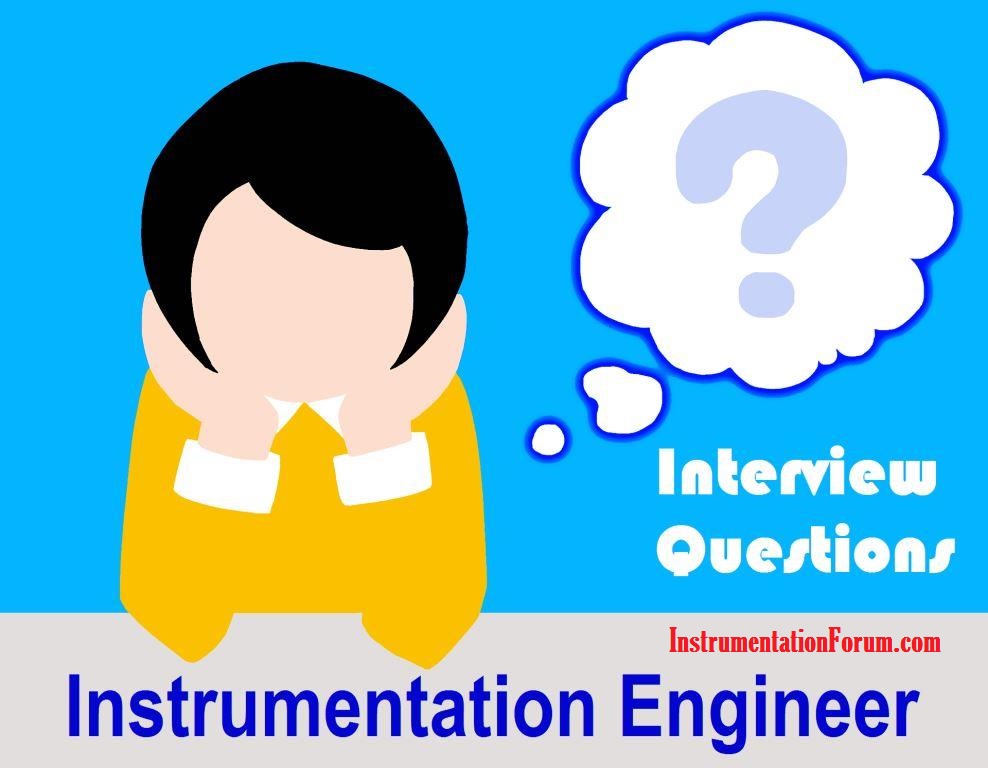Instrumentation Engineer Interview Questions and Answers
Question. Define PID Controller
Answer: A PID Controller ( proportional–integral–derivative controller) is a common control loop feedback controller. The PID Controller is widely and most commonly used in industrial control systems.
A PID controller calculates an “error” value as the difference between a measured process variable and the desired set point. The controller attempts to minimize the error by adjusting the control variable.
Question: What is meant by P, I and D Value in a PID Controller?
Answer: P is Proportional action and depends on the present error.
I is an integral action and depends on the accumulation of past errors,
And D is Derivative action and depends on the prediction of future errors, based on the current rate of change.
The weighted sum of these three actions is used to adjust the process using control variable via a control element such as the position of a control valve.
Question: Define process variable, set point, control variable & error in a PID Controller.
Answer :
Process variable (PV)
The process variable is the current value of the process parameter. The process variable is the parameter that needs to be controlled. For Example- Temperature (ºC), Pressure (psi or kg per square centimeter), Level, Flow. The process variable is measured by a sensor or transmitter. The Process variable is provided as feedback to the PID Controller.
Setpoint (SP)
The setpoint is the set value at which we want to control the process parameter. For example, if want to control the temperature of any tank or body at 300 degrees Celsius, so the setpoint (SP) will be 300 degrees Celsius. Suppose the value of process parameter is 310 degrees Celsius. So 310 degrees Celsius will be the Process variable (PV).
Error
The error is the difference between the feedback signal (PV) and the set value(SP).
Error=set point (SP)- process variable (PV)
Control Variable (cv)
The control variable is the parameter used to minimize the error signal generated. This control variable signal is given to control valve. The control variable is also known as the measured variable (mv).
Question: What are the 2 modes of PID Controller?
Answer: PID Controller has 2 modes.
Auto Mode:
In Auto mode , a particular set point is set and according to this set point, PID Controller adjusts its process variable automatically.
Manual Mode:
In manual mode, no set point is set and we manually open the control valve by adjusting the control variable. This mode is selected mostly for checking control valve opening.
Question: Define I/P Converter.
Answer: A “current to pressure” converter (I/P) converts an analog signal (4 to 20 mA) to a proportional linear pneumatic output (3 to 15 psi or 0.2 to 1.0 Kg/cm^2). Its purpose is to translate the analog output from a control system into a precise, repeatable pressure value to control pneumatic actuators/operators, pneumatic valves.
Question: what is pressure & its unit?
Answer: Pressure is defined as force applied per unit area.
P= F/A.
And its unit is kilogram per square centimeters.
its other units are psi, mmwc, bar, mmHg and many more.
Question: What are the different types of pressures?
Answer:
- Atmospheric Pressure or Barometric Pressure
- Gauge Pressure
- Vacuum
- Line Pressure or Static Pressure or Working Pressure.
- Hydraulic Pressure
- Pneumatic Pressure
- Differential pressure
Question: Why we mostly use platinum RTD.
Answer: because resistance temperature characteristic is most linear than others.
Question: what are different types of bourdon tube pressure gauges with operation range?
Answer: C- type: up to 50 kilograms per centimeter square.
Spiral Type: for low range up to 5 kilograms per square centimeters.
Helical Type : for higher Range up to 300 and above kilograms per square centimeter.
Question: When pointer of temperature gauge will show zero?
Answer: temperature gauge shows the temperature of any process line, body, tank or environment. Its pointer will never show zero reading unless it is zero degree Celsius environment temperature.
Question: Define RTD & how it is checked?
Answer: RTDs are positive temperature coefficient. i.e. Resistance increases with increase in temperature. There are three wires in RTD. Out of them, two wires are short-circuited as shown in the figure. Same color wires are short-circuited.
We will check whether the different color wire is showing the same resistance with the same color wires.
then we will calculate the temperature according to the table or formula provided.
Rt = R0(1+ αt)
